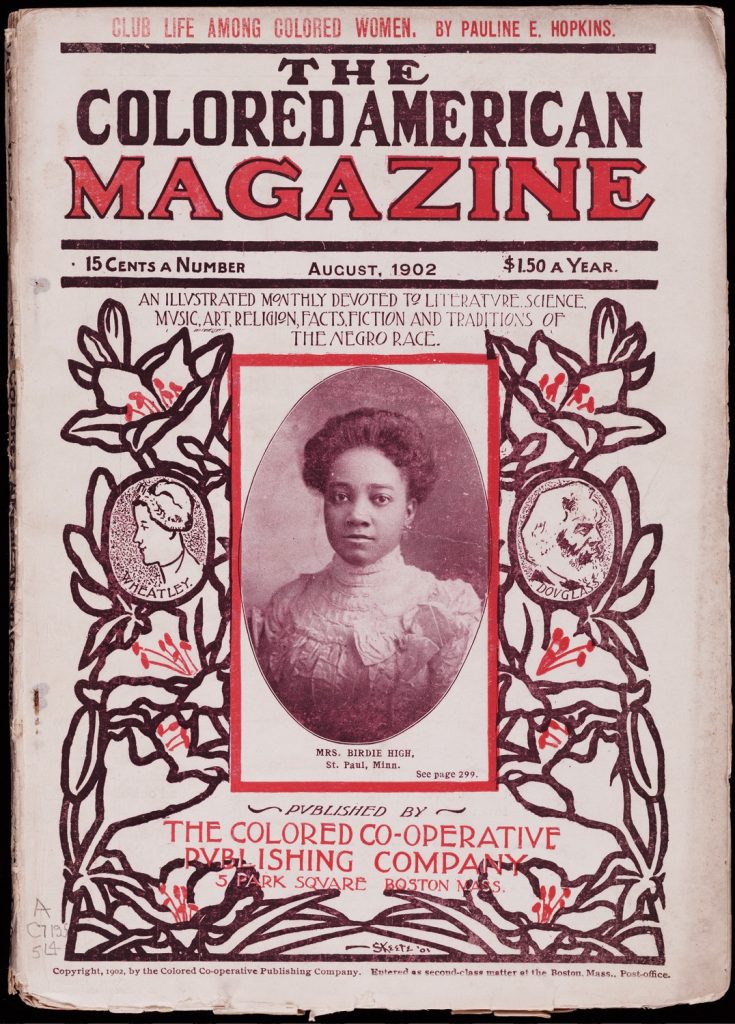
Title:
The Colored American Magazine
Date of Publication:
1900-1909
Place(s) of Publication:
Boston, MA (1900-1904); New York, NY (1904-1909)
Frequency of Publication:
Monthly
Circulation:
~ 17,000 at peak
Publisher:
Colored Co-Operative Publishing Company (1900-1904); The Moore Publishing and Printing Company (1904-1909)
Physical Description:
26 cm.
Editor(s):
Walter Wallace, Pauline Hopkins, Fred R. Moore
Associate Editor(s):
Unknown
Libraries with Original Issues:
Yale University Beinecke Rare Book & Manuscript Library
Reprint Editions:
Negro Universities Press 1969
The Colored American Magazine was founded in Boston by Walter M. Wallace in 1900. It was published by the Colored Co-Operative Publishing Company until 1904 when it was purchased by Fred R. Moore and moved to New York City. The magazine highlights prominent black intellectuals in the northern United States. The magazine aimed to create an outlet for artists, scientists, and thinkers who were excluded and marginalized by white publications. It combined a celebration of Black business success with promotion of African American literary achievement. The advertising section of the magazine aided in pushing its political agenda, so much so that The Colored American was criticized for being too radical during its final years in Boston.
Editors Pauline Hopkins and Fred R. Moore disagreed about the direction the magazine should take. Hopkins pushed for a more middle-class intellectual agenda designed to express the pain of black America’s past, while Moore and Booker T. Washington leaned towards a “more conciliatory politics, shifting its focus away from racial injustices of the past and present toward positive coverage of African American achievements, particularly in the business world” (Sweeney). Ultimately, Hopkins was pushed out of her position, as the magazine’s content grew to differ from her political and literary interests.
No official manifesto exists, but a May 1900 “Announcement” identifies the magazine’s aims:
This magazine shall be devoted to the higher culture of Religion, Literature, Science, Music, and Art of the Negro, universally. Acting as a stimulus to old and young, the old to higher achievements, the young to emulate their example.
(qtd by Dahn and Sweeny, “A Brief History”).
Pauline Hopkins (1859 – Aug. 13, 1930)
Editor: 1901 – 1903
Pauline Hopkins was born in Portland, Maine and raised in Boston, Massachusetts. She was a prolific contributor to Colored American and became editor of the women’s section in 1901 and literary editor in 1903. Hopkins published three serialized novels in the magazine: Hagar’s Daughter: A Story of Caste Prejudiced (1901), Winona: A Tale of Negro Life in the South and Southwest (1902), and Of One Blood; or The Hidden Self (1902-1903). Heavily influenced by W.E.B. Du Bois, Hopkins’ writings were often centered on the black female experience (Cordell). Hopkins was considered outspoken and radical; so much so she was forcibly removed from her post as editor by Fred Randolph Moore, who purchased the magazine and moved production to New York in 1904 (Knight).
Frederick Randolph Moore (Jun. 16, 1857 – Mar. 1, 1943)
Editor: 1904 – 1909
Fred R. Moore was born in Virginia and moved to Washington, D.C.. Before Colored American, Moore worked at the U.S. Treasury Department as an assistant and a delivery clerk at a bank. In 1904, Moore worked with Booker T. Washington to form the National Negro Business League to further the endeavors of black entrepreneurs. The two bought Colored American the same year and moved it to New York. Moore collaborated with the New York Age as a journalist starting in 1905 and purchased the paper in 1907 with the financial backing of Washington. Moore’s vision for Colored American emphasized the business ventures of black Americans, as opposed to Hopkins’ more intellectual and literary leanings (Sweeney).
Cyrus Field Adams
Some Interesting Facts
The Afro-American Council
John C. Danty: Editor, Author, Orator
William Stanley Braithwaite
The Returning Road of Dreams
Robert W. Carter
In Defense of the Race
The Tyranny of the South
Shall the Fifteenth Amendment be Repealed?
James D. Corrothers
The Psalm of a Race
To — (A Sonnet)
T. Thomas Fortune
Here and There: Timothy Thomas Fortune
Cyrus Field Adams
Pauline Hopkins
Hagar’s Daughter: A Story of Southern Caste Prejudice
Winona: A Tale of Negro Life in the South and Southwest
Of One Blood: Or, The Hidden Self
Booker T. Washington
“Up From Slavery”
“Working With The Hands”
“Character Building”
“The National Negro Business League”
Brian Sweeney, and Eurie Dahn. The Digital Colored American Magazine, Web. 14 Sept. 2018.
Cordell, Sigrid Anderson. “‘The Case Was Very Black Against’ Her: Pauline Hopkins and the Politics of Racial Ambiguity at the ‘Colored American Magazine.’” American Periodicals, vol. 16, no. 1, 2006, pp. 52–73.
Knight, Alisha R. “Furnace Blasts for the Tuskegee Wizard: Revisiting Pauline Elizabeth Hopkins, Booker T. Washington and the ‘Colored American Magazine.’” American Periodicals, vol. 17, no. 1, 2007, pp. 41–64.
Compiled by Haley Fullerton (Davidson College, Class of ’20) and Teagan Monaco (Davidson College, Class of ’19)